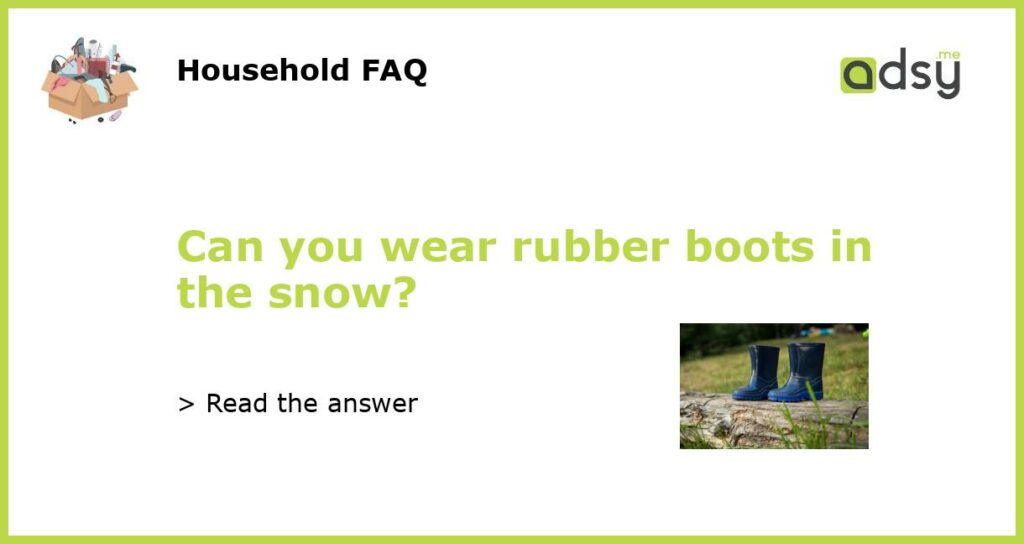Yes, you can wear rubber boots in the snow, but there are some considerations to keep in mind.
1. The Benefits of Rubber Boots in the Snow
2. Insulation and Warmth: Are Rubber Boots Suitable for Cold Weather?
3. Traction and Grip: How Well Do Rubber Boots Perform on Snowy Surfaces?
4. Durability and Waterproofing: Will Rubber Boots Withstand the Winter Elements?
5. Styling Tips: How to Wear Rubber Boots in the Snow and Look Fashionable
The Benefits of Rubber Boots in the Snow
Rubber boots, also known as Wellington boots or rain boots, are traditionally designed to keep your feet dry in wet and rainy conditions. However, rubber boots can also be a practical choice for wearing in the snow. Here are a few benefits of wearing rubber boots in the snow:
- Waterproof: The main advantage of rubber boots is their excellent waterproofing capability. They are designed to keep water out, which means your feet will stay dry even when trudging through snow or slushy conditions.
- Easy to clean: Snow can often be accompanied by mud and dirt, so having boots that are easy to clean is a plus. Rubber boots can be easily wiped down or rinsed off, making them a convenient option for winter wear.
- Protection from cold and moisture: Rubber boots offer a layer of protection from moisture, even when it’s not actively snowing. This can be beneficial if you need to walk through wet or slushy areas during winter.
Insulation and Warmth: Are Rubber Boots Suitable for Cold Weather?
While rubber boots excel in keeping your feet dry, they may not provide the same level of insulation and warmth as dedicated winter boots. Rubber is not known for its insulating properties, which means your feet may get cold in extremely low temperatures. However, this doesn’t mean you can’t wear rubber boots in the snow.
If you plan on wearing rubber boots in the winter, consider adding thermal socks or insoles for extra warmth. These accessories can provide the insulation needed to keep your feet cozy in cold weather. Additionally, layering your socks and using moisture-wicking materials can help regulate temperature and prevent excessive sweating.
It’s important to assess the temperature and weather conditions before deciding to wear rubber boots in the snow. If it’s particularly cold or you’ll be spending a lot of time outside, it may be wise to invest in insulated winter boots designed specifically for cold weather.
Traction and Grip: How Well Do Rubber Boots Perform on Snowy Surfaces?
One of the key considerations when deciding on footwear for snowy conditions is traction and grip. Slipping and falling on icy or slippery surfaces can not only be physically painful but also pose a safety risk.
Rubber boots generally offer decent traction due to their lug soles. The patterned treads on rubber boots can help provide better grip and stability on snowy or icy surfaces. However, it’s important to note that rubber boots may not provide the same level of traction as specialized winter boots with aggressive and temperature-specific sole designs.
If you anticipate encountering icy or slippery terrain, it may be worth investing in boots with enhanced traction features, such as built-in crampons or ice-gripping technologies. These specialized winter boots offer better grip on icy surfaces and are designed to keep you safer in snowy conditions.
Durability and Waterproofing: Will Rubber Boots Withstand the Winter Elements?
In addition to providing waterproofing, rubber boots are generally durable and able to withstand harsh winter conditions. The rubber material is flexible and resistant to cracking, making it ideal for snowy environments.
However, it’s important to choose high-quality rubber boots that are designed for winter use. These boots often have additional features such as reinforced toe caps, higher shafts to keep out snow, and insulation for added warmth. Look for boots that are specifically labeled as suitable for winter or cold weather conditions.
Regular maintenance is also essential to ensure the longevity and performance of your rubber boots. Clean them after use and store them in a cool, dry place to prevent mold or mildew from developing. Applying a protective rubber conditioner can also help maintain the boots’ flexibility and prevent cracking in freezing temperatures.
Styling Tips: How to Wear Rubber Boots in the Snow and Look Fashionable
While practicality often takes precedence in snowy weather, you can still look fashionable while wearing rubber boots in the snow. Here are a few styling tips to incorporate rubber boots into your winter outfits:
- Pair your rubber boots with cozy, winter-inspired clothing, such as a chunky sweater, leggings, and a warm jacket. Layering is key for both warmth and style in cold weather.
- Consider opting for rubber boots in unique colors or patterns to add a pop of personality to your outfit. Floral or animal print rubber boots can add a touch of fun to an otherwise neutral ensemble.
- If you prefer a more streamlined look, choose rubber boots in a classic black or dark color that can easily coordinate with your winter wardrobe.
- Accessorize your outfit with winter accessories like scarves, beanies, or gloves to add extra warmth and style.
- Remember to choose appropriate socks that not only provide insulation but also complement your overall look. Consider choosing wool or thermal socks in coordinating or contrasting colors.
With the right styling and attention to practicality, wearing rubber boots in the snow can be both functional and fashionable.






